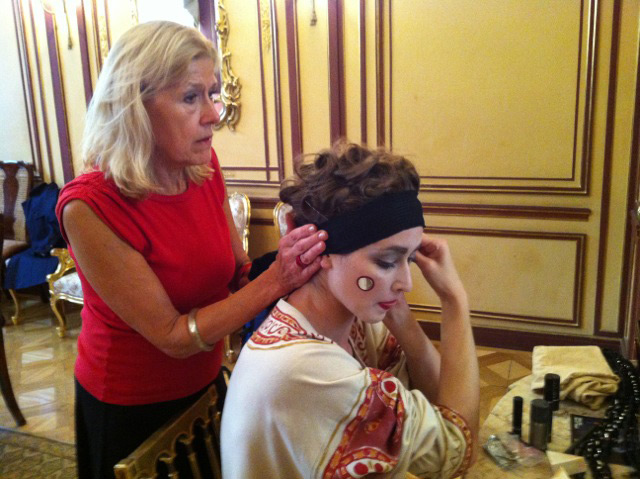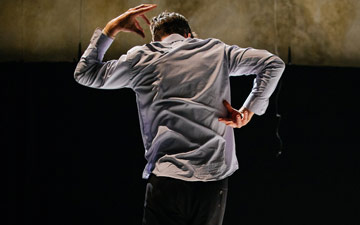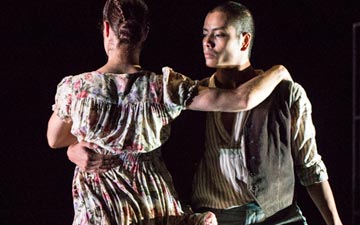
© KMS Press and Millicent Hodson. (Click image for larger version)
Kenneth Archer and Millicent Hodson have contributed a number of articles to DanceTabs and before that ballet.co.uk. Their last piece, on ‘Jeux’ reaching its centenary in 2013, can be found here and includes links to other articles, either by them or about their work.
The Lost Rite
Millicent Hodson, Kenneth Archer, Shira Klasmer
KMS Press
ISBN 099 287 5803, paperback, 250 pages, £54
Book details
Buy the book
www.hodsonarcher.com
www.shiraklasmerphotography.com
Now more than a century old, Igor Stravinsky’s score Le Sacre du printemps is well established in the musical mainstream. The joke about Le massacre du printemps at its Paris premiere in 1913 has long lost its point. Back then one eyewitness described it as weird and barbaric!!!!!!!!! (The exclamations were his.) Now Sacre – or The Rite of Spring – really only comes to life with the edge that youth orchestras bring.
For choreographers, Rite is a rite of passage against which they are measured, as ballerinas are with the great classical roles. Vaslav Nijinsky’s original version was more a scandal than a success. Fascinated by a handful of photographs of dancers posed in strange positions, Millicent Hodson wondered what it might have looked like. In the 1970s she was struck by the modernity of the Chosen One’s plaited hair, as contemporary then as Twiggy in The Boy Friend.
For Hodson and the art historian Kenneth Archer, her husband and partner in crime, in their fascinating detective journey of rediscovery, this was the start of a career in restoration. “Rite was our first child,” Archer jokes. Hodson and Archer have written widely already about their research. Now they have formalised their experiences in a book that draws together their long fascination and unending quest for as many fragments of evidence as they could conceivably find.

© Chris Jones. (Click image for larger version)
Reactions to such works of creative archaeology vary from the thrill of experiencing what Nijinsky’s ballet may have looked like to suspicion about its veracity. Nijinsky’s Rite was lost for 75 years – which means that for 25 years now Hodson and Archer’s reconstruction has successfully entered the repertory of companies around the world. Countless ballets never achieve that length of performing tradition.
Who would imagine that a ballet about the essence of Russianness premiered in Paris would involve an excursion to Bangalore – but that is where Svetoslav Roerich, a son of the ballet’s designer, Nikolai Roerich, had settled. Not only could he help Archer, responsible for reviving the designs, but he also established the sequence of the ballet, visualised in many drawings that Hodson had made from the mass of often-contradictory accounts, sketches, reviews and anecdotes that she had uncovered. Hodson’s challenge had been how to piece these hieroglyphs together. This was the equivalent of Jean-François Champollion’s deciphering of the Rosetta stone.
Marie Rambert, who assisted Nijinsky during the ballet’s creation, had noted her memories of the choreography on the piano score. When interviewed by Hodson she frustratingly could not find them. They were only discovered by the Rambert company’s then archivist, Jane Pritchard, after the choreographer’s death, lost in her wardrobe. Every good detective story can be forgiven such a happy coincidence.

© Chris Jones. (Click image for larger version)
Big claims are made about Nijinsky’s Rite. Hodson considers it the first 20th century ballet, the beginning of modernism and a new way of dancing. How can such claims be made for a production that originally was only performed eight times in Paris and London? When presented by Birmingham Royal Ballet nearly a decade ago I was not convinced by the production as ballet – but I was fascinated by it as a piece of ballet history. Tellingly Hodson refers to it as an artefact.
Hodson’s intimate relationship with the ballet has led her to a deep insight into Nijinsky’s choreography. Every moment, Hodson believes, is a precisely-crafted piece of geometry. When she first attempted to construct a choreographic text from her discoveries she found that Nijinsky’s language of movements felt like classical Cecchetti technique but turned inside out, like a wrong-sided garment. It is Hodson’s belief that Nijinsky’s Rite is not so much a lost ballet but a choreographic tradition that awaited rediscovery. With the disappearance of the ballet, Nijinsky’s ideas were subconsciously rediscovered by choreographers in the 1970s and 80s, Hodson argues.
Now 25 years’ experience of researching and staging the ballet around the world is condensed by Hodson and Archer into a fascinating summary picking up on earlier records. Their early investigations involved studying the 70 or so live pencil sketches undertaken by Valentine Gross during performances, all hugely suggestive. And now in The Lost Rite they incorporate 400 stop-frame photographs by Shira Klasmer that precisely capture a staging by Polish National Ballet.

© KMS Press and Millicent Hodson. (Click image for larger version)
Each photo is paired with a contemporary review or memoir. The result gives a static impression of Nijinsky’s ballet – where each of the 47 dancers in the cast performed different movements to the others, “Like a Petipa ballet condensed into 30 minutes where everybody does something different,” says Hodson provocatively. Less persuasive is the quality of the published book. The repro quality of the photos is serviceable, no more. Roerich’s vivid stage pictures are reproduced in soft focus. A pity too that there is no DVD of the performance included.
But the book is testimony to the remarkable determination and creative vision of Millicent Hodson and Kenneth Archer. They only ever claim that their work is a reasonable facsimile of the originals they investigate – fearful always that somebody will appear with another piece of jigsaw and say ‘Ah but…’ Such is the rigour of their work with The Rite of Spring, that when those moments occur they only reinforce what their tenacious detective abilities have discovered.

















You must be logged in to post a comment.